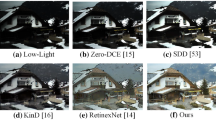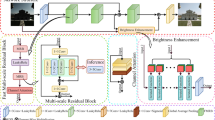Abstract
This paper proposes a Fusion and Recalibration Network (FRN) for low-light image enhancement. Firstly, The proposed method generates multi-exposure images from a single image to enhance low-light images. The proposed Feature Extraction Module (FEM) extracts multi-level features from an image. The proposed method uses Feature Augmentation Module (FAM), a U-net-like structure, to encode the multi-level features and assist in the reconstruction. The proposed Feature Fusion and Re-calibration Module (FFRM) re-calibrates and merges the features to provide an enhanced output image. The advantage of dynamically selecting features from extremely bright regions of the artificially darkened images and darker regions of the artificially brightened image results in a balanced output image. The proposed model was evaluated on various datasets and significantly outperformed most state-of-the-art techniques. Additionally, the experimental assessment shows that the proposed FRN model outperforms other quantitative and qualitative assessment approaches.








Similar content being viewed by others
Data Availability
Data sharing not applicable to this article as no datasets were generated during the current study
References
Amirkhani D, Bastanfard A (2021) An objective method to evaluate exemplar-based inpainted images quality using jaccard index. Multimedia Tools Appl 80(17):26199–26212
Amirkhani D, Bastanfard A (2019) Inpainted image quality evaluation based on saliency map features. In 2019 5th Iranian Conference on Signal Processing and Intelligent Systems (ICSPIS), pp 1–6
Bastanfard A, Amirkhani D, Mohammadi M (2022) Toward image superresolution based on local regression and nonlocal means. Multimedia Tools Appl 81(16):23473–23492
Bellamkonda S, Gopalan N (2020) An enhanced facial expression recognition model using local feature fusion of gabor wavelets and local directionality patterns. Intell J Ambient Comput Intell (IJACI) 11(1):48–70
Bellamkonda S, Gopalan N, Mala C, Settipalli L (2022) Facial expression recognition on partially occluded faces using component based ensemble stacked cnn. Cogn Neurodyn pp 1–24
Bhat N, Saggu N, Pragati, Kumar S (2020) Generating visible spectrum images from thermal infrared using conditional generative adversarial networks. In 2020 5th International Conference on Communication and Electronics Systems (ICCES), pp 1390–1394
Bhowmik A, Kumar S, Bhat N (2021) Evolution of automatic visual description techniques-a methodological survey. Multimedia Tools Appl 80(18):28015–28059
Cai J, Gu S, Zhang L (2018) Learning a deep single image contrast enhancer from multi-exposure images. IEEE Trans Image Process 27(4):2049–2062
Chakraborty S, Singh SK, Chakraborty P (2018) Correction to: Local directional gradient pattern: a local descriptor for face recognition. Multimedia Tools Appl 77(15):20269–20269
Chakraborty S, Mondal R, Singh PK, Sarkar R, Bhattacharjee D (2021) Transfer learning with fine tuning for human action recognition from still images. Multimedia Tools Appl 80(13):20547–20578
Cheng HD, Shi X (2004) A simple and effective histogram equalization approach to image enhancement. Digital signal Process 14(2):158–170
Dabov K, Foi A, Egiazarian K (2007) Video denoising by sparse 3d transform-domain collaborative filtering. In 2007 15th European Signal Processing Conference, IEEE, pp 145–149
Dang-Nguyen DT, Pasquini C, Conotter V, Boato G (2015) Raise: A raw images dataset for digital image forensics. In Proceedings of the 6th ACM multimedia systems conference, pp 219–224
Dehshibi MM, Bastanfard A (2010) Portability: A new challenge on designing family image database. In: IPCV, pp 270–276
Dehshibi MM, Bastanfard A, Kelishami AA (2010) Lpt: Eye features localizer in an n-dimensional image space. In IPCV, Citeseer, pp 347–352
Goodfellow I, Pouget-Abadie J, Mirza M, Xu B, Warde-Farley D, Ozair S, Courville A, Bengio Y (2014) Generative adversarial nets. Adv Neural Inform Process Syst 27
Guo X, Li Y, Ling H (2016) Lime: Low-light image enhancement via illumination map estimation. IEEE Trans Image Process 26(2):982–993
Gupta SS, Hossain S, Kim KD (2021) Hdr-like image from pseudoexposure image fusion: A genetic algorithm approach. IEEE Trans Consumer Electronics 67(2):119–128
Hao S, Han X, Guo Y, Xu X, Wang M (2020) Low-light image enhancement with semi-decoupled decomposition. IEEE Trans Multimedia 22(12):3025–3038
Hebbache L, Amirkhani D, Allili MS, Hammouche N, Lapointe JF (2023) Leveraging saliency in single-stage multi-label concrete defect detection using unmanned aerial vehicle imagery. Remote Sensing 15(5):1218
Hu J, Shen L, Sun G (2018) Squeeze-and-excitation networks. In IEEE conference on computer vision and pattern recognition, pp 7132–7141
Jain G, Chopra S, Chopra S, Parihar AS (2022) Attention-net: An ensemble sketch recognition approach using vector images. IEEE Trans Cogn Dev Syst 14(1):136–145. https://doi.org/10.1109/TCDS.2020.3023055
Jiang Y, Gong X, Liu D, Cheng Y, Fang C, Shen X, Yang J, Zhou P, Wang Z (2021) Enlightengan: Deep light enhancement without paired supervision. IEEE Trans Image Process 30:2340–2349
Jobson DJ, Rahman Zu, Woodell GA (1997) A multiscale retinex for bridging the gap between color images and the human observation of scenes. IEEE Trans Image Process 6(7):965–976
Kalantari NK, Ramamoorthi R et al (2017) Deep high dynamic range imaging of dynamic scenes. ACM Trans Graph 36(4):144–1
Kaur J, Singh W (2022) Tools, techniques, datasets and application areas for object detection in an image: a review. Multimedia Tools Appl pp 1–55
Ledig C, Theis L, Huszár F, Caballero J, Cunningham A, Acosta A, Aitken A, Tejani A, Totz J, Wang Z, et al. (2017) Photo-realistic single image super-resolution using a generative adversarial network. In IEEE conference on computer vision and pattern recognition, pp 4681–4690
Lee S, An GH, Kang SJ (2018) Deep chain hdri: Reconstructing a high dynamic range image from a single low dynamic range image. IEEE Access 6:49913–49924
Li Z, Wei Z, Wen C, Zheng J (2017) Detail-enhanced multi-scale exposure fusion. IEEE Trans Image Process 26(3):1243–1252
Li M, Liu J, Yang W, Sun X, Guo Z (2018) Structure-revealing low-light image enhancement via robust retinex model. IEEE Trans Image Process 27(6):2828–2841
Li H, Ma K, Yong H, Zhang L (2020) Fast multi-scale structural patch decomposition for multi-exposure image fusion. IEEE Trans Image Process 29:5805–5816
Lore KG, Akintayo A, Sarkar S (2017) Llnet: A deep autoencoder approach to natural low-light image enhancement. Pattern Recogn 61:650–662
Lv F, Lu F, Wu J, Lim C (2018) Mbllen: Low-light image/video enhancement using cnns. In BMVC 220:4
Ma K, Li H, Yong H, Wang Z, Meng D, Zhang L (2017) Robust multiexposure image fusion: a structural patch decomposition approach. IEEE Trans Image Process 26(5):2519–2532
MirMashhouri A, Bastanfard A, Amirkhani D (2022) Collecting a database for emotional responses to simple and patterned two-color images. Multimedia Tools Appl 81(13):18935–18953
Mittal A, Soundararajan R, Bovik AC (2012) Making a “completely blind" image quality analyzer. IEEE Signal Process Lett 20(3):20–212
Mittal A, Moorthy AK, Bovik AC (2011) Blind/referenceless image spatial quality evaluator. In: 2011 conference record of the forty fifth asilomar conference on signals, systems and computers (ASILOMAR), IEEE, pp 723–727
Moran S, Marza P, McDonagh S, Parisot S, Slabaugh G (2020) Deeplpf: Deep local parametric filters for image enhancement. In IEEE conference on computer vision and pattern recognition, pp 12826–12835
Pandey NN, Muppalaneni NB (2022) A survey on visual and non-visual features in driver’s drowsiness detection. Multimedia Tools Appl pp 1–41
Parihar AS, Singh K, Ganotra A, Yadav A, Devashish (2022) Contrast aware image dehazing using generative adversarial network. In 2022 2nd international conference on intelligent technologies (CONIT), pp 1–6. https://doi.org/10.1109/CONIT55038.2022.9847710
Parihar AS, Singh K, Rohilla H, Asnani G, Kour H (2020) A comprehensive analysis of fusion-based image enhancement techniques. In 2020 4th international conference on intelligent computing and control systems (ICICCS), pp 823–828. https://doi.org/10.1109/ICICCS48265.2020.9120999
Parihar AS, Varshney D, Pandya K, Aggarwal A (2021) A comprehensive survey on video frame interpolation techniques. Visl Comput pp 1–25
Parihar AS, Verma OP (2016) Contrast enhancement using entropy-based dynamic sub-histogram equalisation. IET Image Process 10(11):799–808
Parihar AS, Singh K, Rohilla H, Asnani G (2021) Fusion-based simultaneous estimation of reflectance and illumination for low-light image enhancement. IET Image Process 15(7):1410–1423
Park S, Yu S, Moon B, Ko S, Paik J (2017) Low-light image enhancement using variational optimization-based retinex model. IEEE Trans Consum Electron 63(2):178–184
Ren W, Liu S, Ma L, Xu Q, Xu X, Cao X, Du J, Yang MH (2019) Lowlight image enhancement via a deep hybrid network. IEEE Trans Image Process 28(9):4364–4375
Ren X, Yang W, Cheng WH, Liu J (2020) Lr3m: Robust low-light enhancement via low-rank regularized retinex model. IEEE Trans Image Process 29:5862–5876
Rohith G, Kumar LS (2021) Paradigm shifts in super-resolution techniques for remote sensing applications. The Visual Computer 37(7):1965–2008
Simonyan K, Zisserman A (2014) Very deep convolutional networks for large-scale image recognition. arXiv preprint arXiv:1409.1556
Singh K, Parihar AS (2021) Variational optimization based single image dehazing. J Visual Commun Image Represent 79:103241
Singh N, Rathore SS, Kumar S (2022) Towards a super-resolution based approach for improved face recognition in low resolution environment. Multimedia Tools Appl 81(27):38887–38919
Singh K, Khare V, Agarwal V, Sourabh (2022) Weakly supervised image dehazing using generative adversarial networks. In 2022 4th international conference on advances in computing, communication control and networking (ICAC3N), pp 870–875. https://doi.org/10.1109/ICAC3N56670.2022.10074393
Singh K, Khare V, Agarwal V, Sourabh S (2022) A review on gan based image dehazing. In 2022 6th International conference on Intelligent Computing and Control Systems (ICICCS), pp 1565–1571. https://doi.org/10.1109/ICICCS53718.2022.9788377
Singh K, Parihar AS (2023) Dse-net: Deep simultaneous estimation network for low-light image enhancement. J Visual Commun Image Represent p 103780
Singh K, Parihar AS (2023) Illumination estimation for nature preserving low-light image enhancement. The Visual Computer pp 1–16
Sivaiah B, Gopalan N, Mala C, Lavanya S (2022) Fl-capsnet: facial localization augmented capsule network for human emotion recognition. Signal, Image Video Process pp 1–9
Ulucan O, Karakaya D, Turkan M (2021) Multi-exposure image fusion based on linear embeddings and watershed masking. Signal Process 178:107791
Vaidwan H, Seth N, Parihar AS, Singh K (2021) A study on transformerbased object detection. In 2021 international conference on intelligent technologies (CONIT), pp 1–6. https://doi.org/10.1109/CONIT51480.2021.9498550
Vishwakarma DK, Dhiman C (2019) A unified model for human activity recognition using spatial distribution of gradients and difference of gaussian kernel. Vis Comput 35(11):1595–1613
Wang Z, Bovik AC, Sheikh HR, Simoncelli EP (2004) Image quality assessment: from error visibility to structural similarity. IEEE Trans Image Process 13(4):600–612
Wang LW, Liu ZS, Siu WC, Lun DP (2020) Lightening network for low-light image enhancement. IEEE Trans Image Process 29:7984–7996
Wang Y, Wan R, Yang W, Li H, Chau LP, Kot AC (2021) Low-light image enhancement with normalizing flow. arXiv preprint arXiv:2109.05923
Wei C, Wang W, Yang W, Liu J (2018) Deep retinex decomposition for low-light enhancement. arXiv preprint arXiv:1808.04560
Xu H, Jiang G, Yu M, Zhu Z, Bai Y, Song Y, Sun H (2021) Tensor product and tensor-singular value decomposition based multi-exposure fusion of images. IEEE Trans Multimedia
Zhang Q, Nie Y, Zhu L, Xiao C, Zheng WS (2020) Enhancing underexposed photos using perceptually bidirectional similarity. IEEE Trans Multimedia 23:189–202
Zheng C, Shi D, Shi W (2021) Adaptive unfolding total variation network for low-light image enhancement. In Proceedings of the IEEE/CVF international conference on computer vision, pp 4439–4448
Acknowledgements
Akshat Agarwal, Mohit Kumar Agarwal, and Aditya Shankar worked on the implementation and analysis. Akshat Agarwal and Ashutosh Pandey worked on exploration and the initial draft of the paper writing. Kavinder Singh and Anil Singh Parihar finalized the problem, guided implementation, revised the rough draft of the paper, and took care of the revision
Author information
Authors and Affiliations
Corresponding author
Ethics declarations
Conflicts of interest
The author has no conflicts of interest to declare that are relevant to the content of this article
Additional information
Publisher's Note
Springer Nature remains neutral with regard to jurisdictional claims in published maps and institutional affiliations.
Rights and permissions
Springer Nature or its licensor (e.g. a society or other partner) holds exclusive rights to this article under a publishing agreement with the author(s) or other rightsholder(s); author self-archiving of the accepted manuscript version of this article is solely governed by the terms of such publishing agreement and applicable law.
About this article
Cite this article
Singh, K., Pandey, A., Agarwal, A. et al. FRN: Fusion and recalibration network for low-light image enhancement. Multimed Tools Appl 83, 12235–12252 (2024). https://doi.org/10.1007/s11042-023-15908-7
Received:
Revised:
Accepted:
Published:
Issue Date:
DOI: https://doi.org/10.1007/s11042-023-15908-7




